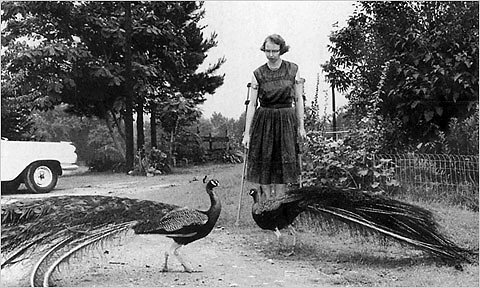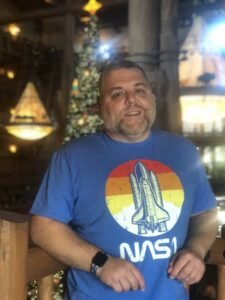American Masters’ Flannery O’Connor documentary sheds light on the Georgia author’s unique view of life.
Growing up on the outskirts of metro Atlanta, the city of Milledgeville was the punch line to jokes for a long time. For many years, the Central State Hospital was probably Milledgeville’s claim to fame (even though the town was the state capitol before Atlanta was), and the line was that if you were crazy enough, someone would take you to Milledgeville.
The funny thing is that Milledgeville has so much more going for it than a mental institution. It’s a college town, with Georgia College & State University responsible for much of the town’s social life, and one of Georgia’s greatest writers called it home.
I’ve cherished Flannery O’Connor’s work for decades, and her name even made its way into my book (which will soon see new life) back in 2015. Her short stories, novels, letters, and published prayer journals have gripped me for their Southernness as well as her emphasis on faith, though her Catholic upbringing and my Christian Church/non-denominational background give us different approaches to Christianity.
The American Masters series on PBS debuted a documentary episode about Flannery O’Connor this week, and the filmmakers have done a good job covering the details of her life and writing and even throwing in a few surprises for longtime fans like me.
Mary Flannery O’Connor was born in Savannah, and she had a brush with fame long before she even dreamed of becoming an author. The Pathé news service sent a film crew to Savannah to film her and her chicken for a newsreel, because the chicken could walk backwards. You know, the kind of scenario that might make its way into one of her stories.
She went to the college in Milledgeville, which was a women’s college at the time, and she planned on a career as a cartoonist – her drawings were witty and sometimes subversive – until her surroundings inspired her to take up fiction writing.
O’Connor desperately wanted people to see her as a person of “cool, sophisticated, clever wit,” but her shyness kept people from truly connecting with her. She wrote in her journal that, “Sometimes I think I would give it all up for just a little social ease.”
The same lupus that took her father’s life afflicted her. She handled her infirmity with grace and good humor, although her condition cost her romantic relationships and eventually took her life too.
The treatment of Catholics in middle Georgia gave her plenty of fodder for unique characters. As her friend Sally Fitzgerald puts it in the documentary:
Catholics were very suspect. So there was always this siege mentality for Catholics. But this was good for Flannery, because it meant that she didn’t take for granted widespread approval. She ignored the disapproval of her religion, she ignored the disapproval of her fiction.
It took some time for her to take off as a writer. Reviewers and Southerners didn’t understand her first novel, Wise Blood, but as her first collection of short stories, A Good Man is Hard to Find, made the rounds, she became a celebrated author.
O’Connor weaved theological and religious concepts into her work with abandon. Her stories brim with wit and profound moral lessons. As Fitzgerald says about the title story in A Good Man is Hard to Find, “Flannery, of course, insisted that this is a story about grace, a woman’s sudden realization of a kinship with a criminal.” As someone who has read this story dozens of times, that revelation brings new light for me.
Because she wasn’t making loads of money off her books, O’Connor hit the speaking circuit and made television appearances. One appearance on the NBC show Gallery-Proof gives a glimpse into her resignation to a writer’s life:
Harvey Breit: I remember that Tomas Mann once said that he hated writing, that it was a trap that he had fallen into. Do you feel that at all?
Flannery O’Connor: Well, I think that you hate it and you love it, too. It’s something that, when you can’t do anything else, you have to do that.
The documentary gives us a fascinating glimpse into O’Connor’s personal life, including her doomed relationships with boyfriends and her occasional antagonism with her mother.
O’Connor could be gregarious and curmudgeonly, often at the same time. Her friend Louise Abbott said, “She could scowl as effectively as anybody I’ve ever known,” but when Breit asked her what a farmer’s life is like, she quipped, “I’m a writer. I farm from the rocking chair.”
A story from her publisher, Robert Giroux, explains how easily O’Connor was willing to buck everyone’s expectations of her:
“Mrs. O’Connor said to me, ‘Mr. Giroux, why can’t you get Flannery to write about nice people?’ I looked at her and started to laugh. Then I looked at Flannery, absolutely poker faced. So I didn’t laugh. Her mother was disappointed that her daughter was not a Southern belle. Instead, she was a writer.”
Naturally, as in any documentary made twenty years into the 21st century, the filmmakers tackle the topic of race. O’Connor’s career took place at a time when racial relations were beginning to change in the South. We hear the N-word in her stories and in other cultural references – curiously, sometimes the filmmakers censor it and sometimes not – and we wonder how O’Connor reconciled the changing face of race relations.
Hilton Als of The New Yorker, himself African-American, takes her in stride when he notes, “She didn’t want to be a spokesman for the South. She was an artist. She could only talk about the South if she was one of its citizens.”
That’s the paradox of Flannery O’Connor. She represents the South in the first half of the 20th century in a way that hardly any other writer could or did, yet there’s something about her work that resonates with people who’ve never set foot in the South. In the Gallery-Proof clip, Harvey Breit calls her a “universal writer,” while actor and fan Tommy Lee Jones says she’s “far more Southern than she is American.”
I thoroughly enjoyed the documentary, and I would probably watch it again. American Masters has done a fine job in capturing the life and spirit of one of Georgia’s most unique writers.
****
Photo by 50 Watts 



Comments
Leave a Reply